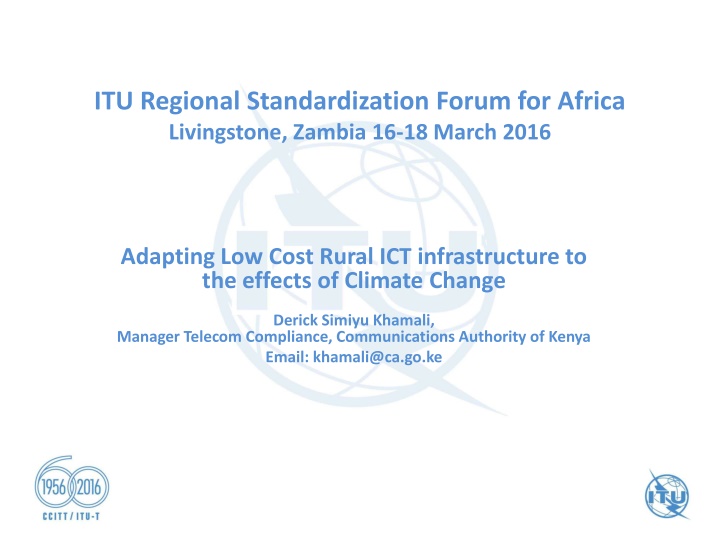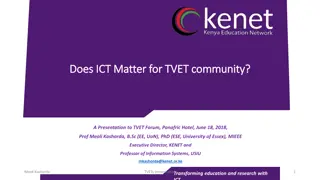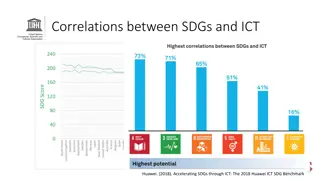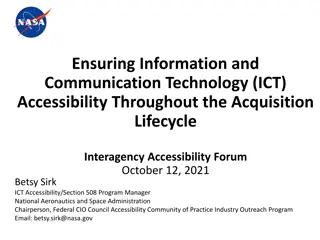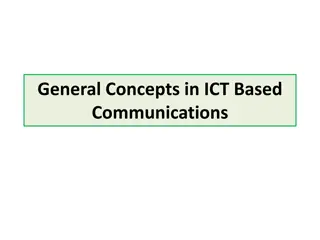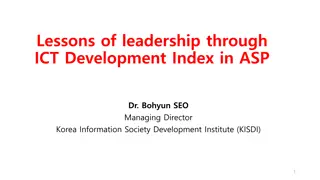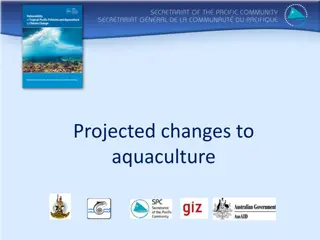Adapting Low-Cost Rural ICT Infrastructure to Climate Change Effects
Explore the adaptation of low-cost rural ICT infrastructure to combat the impacts of climate change, focusing on interdependency, smart sustainability, policy issues, and steps for adaptation in the ICT sector. Concepts like scientific, collaborative, and cost-effective principles are essential for addressing ICT and climate change challenges.
Download Presentation

Please find below an Image/Link to download the presentation.
The content on the website is provided AS IS for your information and personal use only. It may not be sold, licensed, or shared on other websites without obtaining consent from the author.If you encounter any issues during the download, it is possible that the publisher has removed the file from their server.
You are allowed to download the files provided on this website for personal or commercial use, subject to the condition that they are used lawfully. All files are the property of their respective owners.
The content on the website is provided AS IS for your information and personal use only. It may not be sold, licensed, or shared on other websites without obtaining consent from the author.
E N D
Presentation Transcript
ITU Regional Standardization Forum for Africa Livingstone, Zambia 16-18 March 2016 Adapting Low Cost Rural ICT infrastructure to the effects of Climate Change Derick Simiyu Khamali, Manager Telecom Compliance, Communications Authority of Kenya Email: khamali@ca.go.ke
Table of Contents Background ICT Sector Effects of climate change ICT infrastructure ICT Supported items Challenges of CC to the ICT Sector Low cost sustainable ICT services. Role of ICT in Mitigating CC Smart sustainability concept. Progress on the adaptation agenda.
INTERDEPENDENCY INPUTS OUTPUTS PAPERLESS MEETING POWER NEEDS ICT ENVIRONMEN T EDUCATION/TRAINING NEEDS E-MEETINGS PRODUCT/APPLICATION DEVELOPMNT E-COMMERCE
CC PLAYERS Consumers Operators Manufacturers Policy makers NGOs and CBOs Private sector Governments/Administratio ns Regional and International bodies. Infected or Affected
POLICY ISSUES Consumer Protection: Infrastructure sharing Acts, Regulations, Protection Act, 2012. Environmental protection. Treaties and Declarations. Mainstreaming CC in all ICT advancements. Guidelines etc Consumer
Bridging the Standardization gap WHERE HOW WHAT Connect 2020 agenda WHEN WHOM
Steps for adaptation Knowledge/Assessemnt 1 Action / Implementation 2 Monitoring and Evaluation 3 Review and adjustments 4
Concepts to Consider Principles: Scientific Replicable Collaborative Participatory Quick and sustainable Cost effective ICT AND CLIMATE CHANGE
Proposed matrix Adaptation to Climate change and Setting up low cost ICT Infrastructure. Main frame Solution Evaluation Partnership
FLOW Planning Selection ACTION EVALUATION
Benefits Support economies. Ease of business Create employment. Boost economy Bridging the standardization gap. Reduce rural urban migration. Utilize local material and reduce waste Safe lives and transform nations.
Adaptation of Infrastructure Information and Communication Technologies (ICTs) can be part of the solution to climate change by, for example, helping countries adapt to the effects of climate change. At the same time, ICT equipment and infrastructure are themselves exposed to the effects of climate change and therefore need to be both robust and resilient.
IMPACT of CC to ICTs The ICT infrastructure includes outside plant, telecommunication centres,, data centres, base stations and user terminals, including handsets. The ICT devices making up this infrastructure are designed to operate within specified ranges of temperature and humidity, and need protection against dust and/or water ingress. When, ICT devices operate outside their specified environmental conditions, they are at risk of malfunction, failure and/or damage.
IMPACT of CC to ICTs More intense and frequent climatic extremes are expected as a result of climate change. These extremes pose a threat to industries, like the ICT industry, that rely on physical infrastructures. There is an increased risk of service disruption to a range of essential services which now depend on ICT.
IMPACT of CC to ICTs Telecommunication networks and related ICTs must therefore be able to cope with extreme weather events. A more robust and resilient infrastructure may be required in future than the infrastructure that is in operation today Costs can be greatly reduced by considering the requirements at the initial design stage rather than by retrospective upgrade. The need for the ICT infrastructure to cope with extremes of climate or adapt to its effects can be considered from two complementary perspectives the direct and the indirect perspectives.
IMPACT of CC to ICTs Direct effects of climate change on ICTs include the vulnerability of ICT equipment to extreme weather events such as increased flooding, wind speed, precipitation, humidity, temperature, snow and ice fall and lightning strikes.(Discussed below)
Recommendation ITU-T L.92 Recommendation ITU-T L.92 deals with disaster management for outside plant facilities. It gives an overview of the technical considerations for protecting outside plant facilities from natural disasters. Disaster management for outside plant facilities such as cables, poles and manholes from natural disasters such as earthquakes, strong winds and floods.
TEMPERATURE The failure rate of an electrical component increases exponentially with temperature. Each component has an activation energy that is characteristic of its chemical composition. Failure will result when the temperature rises sufficiently to cause breakdown in the chemical or crystal lattice.
RAINFALL/FLOODING Telecommunications buildings and infrastructure can be at risk from extreme rainfall and flooding, depending on location. This risk may increase in frequency or severity as a result of climate change. If the electricity grid fails, the backup power systems may also become awash, and power can then only be maintained by other backup such as batteries. It should be noted that severe climate events , are now happening much more frequently than in the past.
RAINFALL/FLOODING Possible remedial work to make central offices less vulnerable to flooding would be to raise equipment from the ground floor to higher floors. Large telecommunication sites (typically in cities) have large batteries that could be as much as 10,000Ah @48V. Due to their weight, to cope with the building s structural stability needs, such batteries are typically installed at ground/underground level which may be subject to flooding.
LANDSLIDES Telecommunication lines are frequently laid along roadsides which are vulnerable to landslides. The risk of landslide and avalanche is increasing due to deforestation and climate change. Landslides can be caused by over steepening or over loading of slopes, earthquakes, tsunamis, hurricanes, flooding, erosion and other severe weather events, or by vegetation loss as a result of logging, development or wildfires. Mitigation measures include planting ground cover (low growing plants) on slopes. Rainfall thresholds for the initiation of landslides have been studied. Regional and local thresholds cannot be easily exported to neighbouring areas. Landslides could cause telecommunication poles to fall, bringing down aerial cables.
WINDS ICT facilities at risk of damage include buildings, overhead lines and antennas. Overhead lines provide fixed access connectivity at lower cost than underground ones, but the cables are vulnerable to the effects of wind through damage by falling trees and gradual wear out due to metal fatigue and vibration ITU-T L.26. In areas more prone to falling trees, the route of new overhead lines should be kept at reasonable distance from trees. When this is not possible, trees close to the line should be cut to form a safety zone Antennas are at risk due to winds exceeding their design limit such as the ability to withstand 70 m/s (252 km/h) wind speed (IPCC 4th AR). Based on a range of models-future tropical cyclones will become more intense, with larger peak wind speeds and heavier precipitation due to an increases of tropical sea-surface temperature.
WINDS In some locations, such as the pacific island of Guam, the IPCC Special Report [b-IPCC SR]states that buildings are required to withstand peak gust wind speeds of 76 m/s, expected every few decades (International Building Codes, 2003). This higher limit could be applied to ICT buildings and antennas in risk areas. The latest version of the International Building Code is available online. Chapter 1612 of the [b-IPCC SR] includes maps of rainfall, seismic, snow and wind criteria across the USA. In general, coastal regions can be expected to have higher maximum wind speeds. Wind load is proportional to the square of the wind speed. If the wind speed increases by 10% in a region as a result of climate change, then the load acting on a structure will increase by 20%. It is therefore important to monitor the latest building regulations for the region and consider if the wind speeds and loads quoted are sufficient for the life of the building, which could be a century or more. Whilst care must be taken when designing antennas to ensure safety to persons, pointing accuracy also must be considered. If the mast carries highly directional antennas such as microwave dishes, the structure must be able to maintain pointing accuracy. In some cases, a 0.1 degree displacement will be sufficient to cause loss of service. In a storm both ends of the link are likely to be affected. System margin therefore needs to be added to allow for losses due to wind and pointing accuracy. Excess wind is normally allowed for in the antenna and mast design so that no permanent bending occurs in the structure. After the storm is over, the signals should then return to normal level. In the context of adaptation to climate change, it would be wise to consider a 20% stiffening of the structure over current building regulations to allow for the possible 10% increase in extreme wind over the coming decades.
Lighting The risk of damage to equipment at telecommunication sites due to lightning can be assessed by risk analysis. ITU- T has published ten K-series Recommendations on this topic (see the Bibliography).(list the 10 recommendations and entries for each in bib) More research is needed to determine if, in order to take climate change into account, the values of the parameter 'number of strikes per year' need to be increased (or decreased) with respect to the values on keraunic (lightning strike) maps for the locality. Adequate grounding is necessary. If changes in climate and weather patterns occur, soil moisture content and resistivity will change as well, and prolonged drought could cause significant increase in grounding resistance, even beyond safety limits. This can affect the safety of maintenance workers, the resilience of infrastructure to lightning, and the performance of power supply systems and telecommunications networks. It may therefore be necessary to install additional protection in some locations. In mains-powered cabinets and remote base stations, an increase in the grounding resistance or an increase in the frequency and strength of lightning could cause an increase in the residual current circuit breaker trips. This could cause prolonged service disruption as a truck roll is normally required to reset the circuit breaker. To increase resilience against these unwanted power breaks, it is advisable to install either high-noise-immunity differential switches (reinforced immunity) or self-restoring breakers. Self-restoring breakers typically include a control system that verifies the integrity of the system and prevent reactivation if a permanent fault is detected, such as a ground fault caused by a breakdown of the insulation.
Humidity Humidity can affect the reliable operation of ICT systems. Effects such as corrosion under high humidity and damage due to static electricity under low humidity are well known. Most important is condensation which occurs when there is a change from a cold environment to a warm and humid one such as when a device is moved in winter from outdoors to an indoor heated room. More work is needed to determine the direct impact of extreme humidity on ICT infrastructure. However, there may be an indirect impact on the workforce required to install and maintain networks. The combination of high temperature and humidity in some areas for parts of the year is expected to compromise common human activities, including growing food and working outdoors (high confidence). [b-IPCC 2014].
Drought Drought is illustrated by dry, cracked earth; low reservoir levels; barren fields. There are different types of drought though, each of which is measured differently. The meteorological drought is reflected by levels of precipitation, assessment of the degree of dryness (in comparison to a local or regional average) and the duration of the dry period. There is also hydrological drought, or how decreased precipitation affects stream-flow, soil moisture, reservoir and lake levels, and groundwater recharge. Agricultural drought occurs when water supplies not being able to meet crop water demands. The changes in precipitation regimes can lead to long periods of drought, increasing the risk of subsidence, hence affecting the stability of foundations and tower structures. Corrosion rates can result from this phenomenon and require different equipment maintenance schemes for ICTs. This could lead to the degradation of ICT infrastructure, business cost and safety risks to personnel. Some telecommunication installations have a pond nearby to provide water to extinguish fires. The level of this pond must be maintained to cope with extreme drought conditions. Among the cooling technologies used in ICT plants there are some that need large amounts of water in the refrigeration cycle. For large sites water is used in the heat exchangers, while in other sites evaporative cooling is increasingly used. In case of drought, this raises the problem of possible diversion of water from the needs of the population. Lack of water would be critical to such cooling systems as lack of water would stop their functioning, with the consequent increase of temperature to the ICT equipment. This could cause malfunction of the ICT service and even failure.
ICE STORMS/SNOW FALL Ice storms and heavy snowfall can cause failure of electricity transmission lines, causing power outage of ICT services through lack of local supply. These weather events can also be responsible for damage to the telecommunication lines, for example, when a branch breaks from a tree onto a telephone line and when ice forms around the aerial cable, increasing its weight and its surface exposed to wind (more stress). Radio systems are affected when antennas are covered in ice. The IPCC [b-IPPC 2014] have reported that There is very high confidence that the extent of Northern Hemisphere snow cover has decreased since the mid-20th century by 1.6 [0.8 to 2.4] % per decade for March and April, and 11.7% per decade for June, over the 1967 to 2012 period." However, it seems likely that extreme events are increasing as a consequence of climate change. A recent example of the consequences of ice storms is noted in the New York area. The ClimAID Report includes a chapter on Telecommunications [b-ClimAid]. It says: The December 2008 ice storm in New England and Central and Upstate New York formed late on December 11 and dissipated meteorologically by December 12. Its impact, however, lasted for more than a week in New York and in large portions of New England Telecommunications services were disrupted as a result of damaged lines, and electronic equipment in homes lost power. Cable-provided voice, video, and data services had problems at twice the normal levels during the week following the storm. Damage was primarily a result of fallen trees, utility wires, and poles, which were coated in a heavy layer of ice. The slow return of power in the aftermath of the storm resulted in a great deal of controversy about why the utilities could not restore services more expediently, if not avoid outages in the first place.
OTHER TOPICS Indirect consequences of climate change for ICTs Vehicles and climate change adaptation Workforce and climate change adaptation Supply chain and climate change resilience ICT end-user services and equipment Checklist Below.
Temperat ure raise Humidity Wind loading Rise in Sea level Rainfall Floods Landslide s Snow and Ice fall Lightning strikes Effect Infrastruc ture Tower L L H M L H M L H Antenna M M H L H M M H H Electronic s Equipment room Fibre Optic Twisted pair cables H H L L M L L L H M M L H H H L L H L L L L L* L H* L L L L H M** M H H** M H And coaxial cables Grid supply Standby generators Satellite Earth Stations HVAC L*** L L M M H M M H L L L M** M H H** H M L L H M H/M M M H H H M L L L L** L L L
CONCLUSION ADAPTION IS A MUST FOR A CONNECTED FUTURE AND SUSTAINABLE CITIES. BRIDGING THE STANDARDISATION GAP IS CRITICAL FOR SUSTAINABILITY WASTE CAN BE TURNED INTO WEALTH WHEN MANAGED WELL.
Thank You! khamali@ca.go.ke www.ca.go.ke
